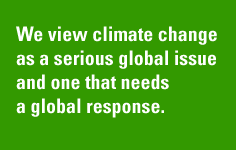YOU ARE HERE: CSE Report 2005 > Energy & Greenhouse > Greenhouse Gases & Climate Change

Steelmaking generates greenhouse gas emissions, mainly carbon dioxide, both directly when making iron and steel, and indirectly through the use of electricity and gas in a range of steel manufacturing processes.
The majority of greenhouse gas emissions occur during the iron making process, where coal and coke is used as a chemical reductant to extract iron from iron ore in the blast furnace.
An increased concentration of greenhouse gases in the earth's atmosphere is believed by many experts to contribute to the phenomenon of global warming, leading to climate change.
BlueScope Steel accepts that climate change is occurring, although the nature and timeframe of its impacts are uncertain. We view climate change as a serious global issue and one that needs a global response.
In this context, the Company supports the Australian Government's commitment to reduce Australia's greenhouse gas emissions to 108 per cent of 1990 levels over the period 2008-2012.
BlueScope Steel's operations are subject to greenhouse gas regulation in a number of jurisdictions.
In New Zealand, we are currently undertaking a negotiated greenhouse agreement with the New Zealand Government, after that country ratified the Kyoto Protocol.
In New South Wales, that State's Greenhouse Gas Abatement Scheme regulates emissions from the stationery energy sector, thereby increasing the cost of electricity purchased by BlueScope Steel.
And Australia's States and Territories are currently proposing a national emissions trading scheme, based on a 'cap and trade' mechanism.
As nations develop their economies, demand for steel products increases. Meeting this growing demand while improving the world steel industry's greenhouse intensity is an enormous challenge. It is a challenge that requires a global response.
Global demand for steel products is driving large increases in production, especially in developing countries such as China and India.
Regulation of greenhouse gas emissions in developed countries only is likely to lead to the relocation of steel production to the developing world.
Relocating steel production to the developing world is not likely to reduce worldwide greenhouse gas intensity, and may actually increase intensity if less efficient technology is used.
That is why measures to cut greenhouse gas emissions must be comprehensive and global, covering both developed and developing countries. Such measures must also take account of the legitimate aspirations of all countries for economic development.
BlueScope Steel believes technology solutions will be important in meeting the greenhouse challenge. This includes technology that reduces emissions from energy generation, and technology that cuts emissions from steelmaking itself.
Research currently being undertaken in Europe - the Ultra Low CO2 Steelmaking (ULCOS) project - aims to find new ways of producing steel that result in significant reductions in greenhouse gas emissions.
This is a long-term project to develop breakthrough technologies that could result in a paradigm shift in steel manufacturing processes. A wide range of technologies for reducing greenhouse emissions are being examined, including carbon-lean technologies combined with carbon capture or sequestration, and innovative use of natural gas, hydrogen, biomass and electricity.

